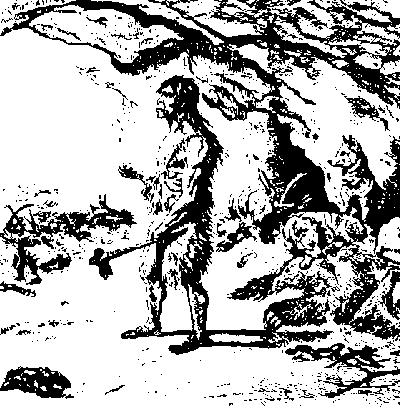 |
Science Frontiers ONLINE No. 104: Mar-Apr 1996 |
|
|
Reinventing The Neandertals
The public image of the Neandertal is that of a brutish, hardly human creature clad in a ragged skin and unable to speak save for a few grunts. Forget that picture. Several hundred meters deep inside a cavern near Bruniquel, in southern France, spelunkers stumbled across a complex quadrilateral structure, 4 x 5 meters in extent, built up from chunks of stalactites and stalagmites. Within its "walls" they found a piece of burnt bear bone that was later carbondated as at least 47,600 years old. A burnt bone and a geometrical structure certainly suggest the work of an intelligent creature, as does the site's great distance from the surface. Torches would have been a necessity that far in. That 47,600-year figure, though, presents a problem. The first Cro-Magnons didn't filter into western Europe until about 35,000 BP. According to the accepted anthropological schedule, only those subhuman Neandertals inhabited that part of France in 47,600 BP. So, we must conclude that the Neandertals knew well the sophisticated use of fire. They also had enough curiosity to venture deep into the earth, where for some unknown purpose they piled together an enigmatic structure. All this also seems to require more information transfer than possible with a few "ughs"!
(Balter, Michael; "Cave Structure Boosts Neandertal Image," Science, 271:449, 1996)
There is always the possibility that those mysterious Cro-Magnons, who seem to have appeared out of nowhere, got to western Europe ahead of schedule. They are probably the artists who made those 31,000-year-old cave paintings at Grotte Chauvet in southern France. Even though of slighter build and smaller brains, the Cro-Magnons are thought to have quickly replaced the Neandertals.
Complicating the picture is abundant fossil evidence of so-called "archaic" Homo sapiens in Europe commencing some 500,000 years ago. Did these archaic versions of modern humans evolve into Neandertals before the Cro-Magnons (modern humans) arrived on the scene? Some paleoanthropologists now believe so. Just the other day it was generally thought that Homo erectus rather than "archaic" Homo sapiens gave rise to the Neandertals.
(Hublin, Jean-Jacques; "The First Europeans," Archaeology, 49:36, January/ February 1996)
Comment. We, too, are confused. Don't take these human evolutionary family trees too seriously. They change with each new "find," and these seem to come several times each year.
Reference. Human evolution, as seen in the fossil record, is covered in section BHE in our catalog: Biological Anomalies: Humans III. Ordering information here.
 | How a Neanderal was pictured in an 1873 issue of Harper's Weekly. No senstive, caring, loquacious man he! |